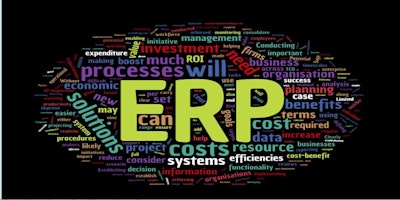
Conducting a
cost-benefit
analysis for ERP
analysis
for ERP
The number of businesses and organisations embracing enterprise
resource planning (ERP) has increased at a steady rate in recent years.
More firms have been attracted to the discipline by the desire to integrate
and consolidate management information, and make data available to
decision makers throughout the enterprise.
In a survey conducted by the Aberdeen Group, nine out of ten manufacturing firms said they had implemented ERP
solutions in a bid to improve resource planning, drive efficiencies and boost organisational growth. And according to
a study conducted by Panorama Consulting, almost nine out of ten (86 per cent) firms using ERP are satisfied with the
results of their initiative.
Conducting a cost-benefit analysis for ERP
Establishing an economic case
for investment
But before implementing ERP across their organisation, business
leaders need to establish an economic case for investment. It is
important to weigh up the costs - in terms of both capital and
operational expenditure - and then compare this to the expected
return on investment (ROI).
Where the projected ROI exceeds the total cost of ownership
(TCO), resource planning should have a positive impact on
profitability, making investment in ERP processes and systems
easy to justify. However, it is important for budget holders to
consider a full range of potential costs and benefits - based on
their own characteristics and ERP needs - before committing to
a particular course of action.
Potential costs of ERP initiatives
In terms of ERP costs, businesses need to consider:
• Acquisition - how much will it cost to deploy the ERP
solutions required to improve the quality and accessibility of
your management information, and then draw insight from the
data? Is there a need to invest in new hardware to support
the functionality of ERP solutions?
• Customisation - how much will your firm need to spend
implementing solutions to fit your business model, and those
of any individual divisions or subsidiaries requiring their own
tier of ERP? New ERP solutions will need to be integrated
with existing systems.
• Testing - where ERP solutions are being deployed, the
technology partner will be required to carry out technical tests
to ensure the user will benefit from full functionality. This may
also require some involvement from your staff, taking them
away from their normal work duties.
• Upgrades - how much will it cost to conduct periodic ERP
reviews, and carry out any upgrades that may be required
over time? How much will it cost to add extensions to the
system to increase functionality?
• Conversion - how much will it cost to convert files to the new
ERP system, and consolidate management information on the
news platform? What will be the financial impact of phasing
out old procedures and legacy solutions?
• Personal Development - how much will it cost to
reorganise your workforce, update manual processes and
train employees to use the new ERP solutions? Consider the
need to deliver ongoing support to the workforce, with regular
training rather than a one-off introductory session.
• Unforeseen expenditure - there are always likely to be
some costs which cannot be budgeted for when revising
operational processes and introducing a new way of working.
Costs need to be considered on a monthly and yearly basis, in
a bid to establish a best and worst-case scenario for spending
on ERP. This provides a benchmark for projecting return on
investment, and establishing the economic benefits likely to be
delivered through an ERP upgrade.
Conducting a cost-benefit analysis for ERP
Potential benefits of ERP initiatives
ERP processes can offer a number of benefits to organsiations,
including:
• Streamlined procedures - the use of ERP solutions and
streamlined resource management processes can help
simplify procedures, helping to reduce re-work and manual
handling costs.
• Greater intelligence - decision makers can monitor
performance in individual departments and across the
organisation as a whole, and consider the inter-dependence
of different areas. Integrated data supports effective decision
making processes.
• Increased productivity - Manual tasks can be automated,
helping to increase speed of delivery, boost accuracy and
reduce the pressure on employees. Key workers can focus
on value adding tasks, enabling them to boost productivity
and output.
• Greater reliability - ERP systems can flag up inaccuracies
and errors, allowing decisions to be based on more relevant
and accurate data. As such, firms are able to reach the
most desirable outcome more frequently, which should help
achieve efficiencies and boost customer engagement.
• Improved reporting - Benchmarking is easier, as ERP
systems make it simpler to record and report data across a
range of tangibles. Monitoring business processes becomes
easier, enabling earlier troubleshooting.
Clearly defining targets for the ERP initiative, and then monitoring
the success of the project in achieving these, is all-important.
Without a clear set of end goals, organisations may find it difficult
to set realistic expectations, in terms of timescales and costs.
Setting the level of expectation
It makes sense to be conservative when projecting the economic
benefits of new ERP systems and processes. If the goals
for your project are set unrealistically high, they are unlikely
to be achieved - impacting on the perceived success of the
implementation.
Working out a ‘worst case’ cost scenario, along with a ‘likely’
estimate, is also advisable for businesses and organisation. This
should help ensure there are no unpleasant surprises, in terms of
the ROI of the ERP project, further along the line.
Establishing a sound business case for investment in ERP
is vitally important, particularly in a tough economic climate
with budgets remaining constrained. This gives project goals
a strategic context, making it easier for executives to decide
whether to opt for ERP.
Achieving maximum value from ERP
The challenge for your organisation is to maximise the potential
benefits of ERP post-deployment, while keeping costs under
tight control. One of the ways this can be achieved is by carrying
out regular process reviews, using both quantitative data and
direct feedback from personnel involved in resource planning.
Identifying flaws in existing ERP systems, or areas where
improvements could be made, gives your organisation the
chance to either add value or increase efficiencies. If aspects of
the resource planning system are not working, amendments can
then be made - either to the software deployment or to people
processes as required.
In successful implementations - which have been properly
planned in consultation with an ERP expert - the ROI should
ultimately exceed the TCO, delivering value to the user.
Examples include:
• Lakeside Plastics increasing business by 15 per cent from a
similar cost base using ERP.
• Columbia Manufacturing cutting the use of utilities by up to 98
per cent to reduce expenditure and increase its profit margin.
• Urban Ministries reporting “remarkable efficiencies and
savings” in order processing - which used to take days but
is now completed “within a matter of minutes” - as well as
reduced shipping and production costs.
“Clearly defining targets
for the ERP initiative, and
then monitoring the success
of the project in achieving
these, is all-important.
Without a clear set of end
goals, organisations may
find it difficult to set realistic
expectations, in terms of
timescales and costs.”
Sage (UK) Limited
Noth Park
Newcastle
NE13 9AA
Telephone: 0845 485 9800
Email: [email protected]
Web: www.sage.co.uk/x3
© Sage (UK) Limited 2013 07/13 18652LC
Paper from well managed forests
If you’d like this information in another format, please
call Customer Care on 0845 111 66 66 or email
[email protected] so we can consider your request.






















